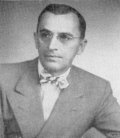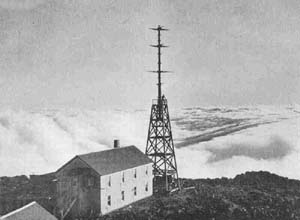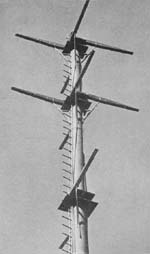On October 31, 1940 the Federal Communication Commission granted a Construction Permit for a
commercial FM station on Mt. Washington, on a frequency of 43.9 megacycles.
Licensed to the city of Boston with studios at 21 Brookline Avenue.
|
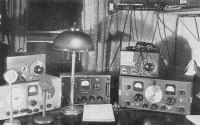 |
The FM station goes on the air December 18, 1940, operating with
a 1 kilowatt transmitter. Call letters W39B are assigned to the facility.
Power will increase to 5 kilowatt when a new transmitter is
moved up the mountain, once the weather improves.
|
| |
|
In anticipation of the power increase,
a power plant is built in the summer of 1940 by Yankee,
in a separate building, adjacent to the weather observatory.
The new building will house two General Motors generators,
one having 40 kva output, the second unit produces 10 kva.
Space is made available for two additional generators.
|
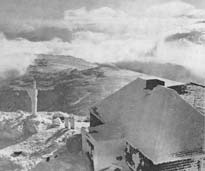
|
| |
|
Plans are formulated for the spring of 1942,
when Yankee will construct its own building atop Mt. Washington.
|
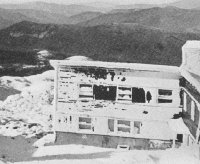 |
There will be enough room to accommodate 10 people
as well as a ten kilowatt transmitter and support equipment.
The new transmitter building will have the luxury of running water.
In the past water had to hauled from the 4,000 foot level of the 6,300 mountain.
(A total of 720 drilling hours was required to strike water at the 1,100 foot level)
Safety concerns dictate that the "Power Building" remains a separate entity .
|
| |
In 1942 the FM stations of John Shepard 3rd are operating 24 hours a day because of their importance
in the war effort. The Government's Interceptor Command is especially interested in using these
stations to relay critically important and time sensitive information to the general public thru these facilities.
The Yankee Network's W39B and W43B can be received by 51 out of 52 stations in New England.
|
| |
|
In December 1942, the General Tire and Rubber of Akron Ohio purchases
the four AM and two FM stations of the Yankee Network,
John Shepard 3rd remains as manager under a five year contract.
|
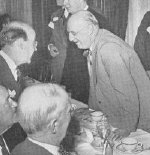 |
| |
As a result of changes mandated by the Federal Communications Commission, on November 1, 1943,
W39B, Mt. Washington became WMTW and W43B is now WGTR.
The FCC and the industry feel that the new calls, using all letters,
instead of the current alpha/numerical designation, will be less confusing to the general public.
The city of license is also changed from Boston, Massachusetts to Portland, Maine for WMTW
and Paxton (Worcester) for WGTR.
|
| |
| |
With the onset of 1946.....,
|
 |
The FCC orders FM broadcasting to move to the new FM frequencies (88-108 mc).
The stations will operate on both the low and high band frequencies to insure an
orderly transition, WMTW is assigned 98.1 mc.
In the fall, the call letters are changed to WMNE, the high band station
is operating with an ERP of 23 kw using a four bay antenna.
In December, the low band frequency is changed from 43.9 to 45.1 mc.
The accompanying photo shows the new high band antenna mounted above the 2 bay
low band antenna on Mt. Washington.
|
| |
|
| |
The late forties are relatively quiet years for Yankee FM.
In 1947 the studios are moved to 212 Middle St. in Portland, Maine.
A frequency re-alignment in October, 1947 moves the high band frequency to 100.5 mc
The station is still transmitting on both low and high bands.
"...then of course, there are the two pioneer Yankee Network radiators at Paxton
and Mount Washington.
FM's greatest showpieces,
which for a long time have been serving the crowded population centers of New England."
|
|
|
| |
September 1948
"..the high cost of operation and limited public acceptance..."
lead to the end of the line for WMNE / Mount Washington.
|
|
The 10 kw REL transmitter is moved from Mt, Washington
to the new WNAC-TV transmitter site in Boston.
In October 1948 it became WNAC-FM on 98.5 mc.
|
|
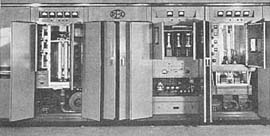 |
| |
| |
June 11, 1950
The broadcast industry lost one of it's most active
and successful pioneer, with the passing of
John Shepard 3rd.
Milton Sleeper - FM Magazine
|
Tragedy struck one of America's great transmitting location
On Sunday February 09, 2003, fire destroyed the WMTW-TV building,
along with it's capacity to generate all electrical power to the mountain.
Also destroyed was the historical Yankee Power Building, mentioned above.
|
For a
companion Mt. Washington page, check out WMTW-TV
and FM
|
|
|
